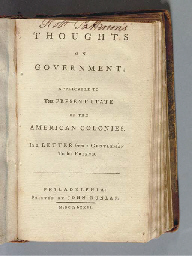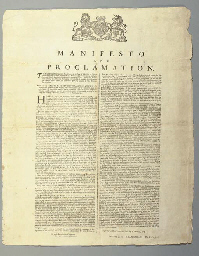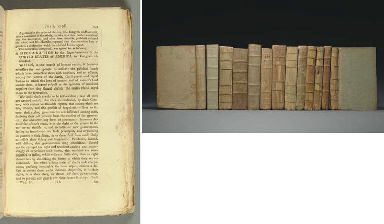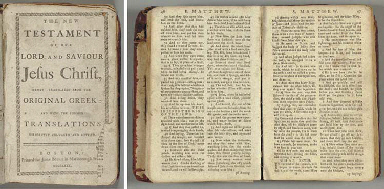GIBBES, Charles Drayton (1815-1893). Accompaniment to Gibbes' New Map of the Gold Region of California . Stockton, Calif.: C. Drayton Gibbes; New York: Sherman & Smith, 1851. 12 o (137 x 189 mm). 16 pages. Large folding hand-colored lithographed map "A New Map of the Gold Regions of California" (710 x 495 mm) (two small glue stains where originally attached inside volume, a few tiny separations at folds, OTHERWISE IN VERY FINE, FRESH AND BRIGHT CONDITION). Original brown blind-stamped cloth, gilt-lettered on upper cover. FIRST EDITION OF ONE OF THE MOST IMPORTANT AND RAREST MAPS OF THE CALIFORNIA GOLD RUSH. Charles Gibbes came to California from Charleston, South Carolina during the Gold Rush. "This map...because of its large scale [about 20 miles to the inch] and clear markings in colors of the different counties, is one of the most satisfactory of the early California maps. It shows the state before Klamath County in the north, and Nevada and Placer counties in the center, had been set apart and thus gives an earlier representation than the Butler map published the same year which shows those new counties...An important feature of Gibbes' map is that it is one of the first, if not the first, map of California to show county boundaries" (Streeter). Gibbes' map was published within a year of California being admitted into the Union as a part of the Compromise of 1850. Gold production reached its peak in 1852, the year after the map was published. Many mining camps are pictured, including Toualamne City, Empire City, Jacksonville, Downingville, Coloma, Buck's and Illinoistown. The accompanying text provides a description of California, its history, climate, soil, crops, bays, harbors and rivers. Gibbes also gives pertinent information on the mines and advice for equipment. "Towns have sprung up at all the principal mining centres, and trading establishments in them furnish all needed supplies of provisions, clothing, tools, and other necessities, at reasonable rates." Gibbes estimated that $100 million in gold had already been mined. Not in Phillips Maps . Cowan II p. 234; Decker 36:167; Holliday 428; Howell 484; Kurutz 270; Streeter V:2663; Wheat Maps of the California Gold Region 192.
GIBBES, Charles Drayton (1815-1893). Accompaniment to Gibbes' New Map of the Gold Region of California . Stockton, Calif.: C. Drayton Gibbes; New York: Sherman & Smith, 1851. 12 o (137 x 189 mm). 16 pages. Large folding hand-colored lithographed map "A New Map of the Gold Regions of California" (710 x 495 mm) (two small glue stains where originally attached inside volume, a few tiny separations at folds, OTHERWISE IN VERY FINE, FRESH AND BRIGHT CONDITION). Original brown blind-stamped cloth, gilt-lettered on upper cover. FIRST EDITION OF ONE OF THE MOST IMPORTANT AND RAREST MAPS OF THE CALIFORNIA GOLD RUSH. Charles Gibbes came to California from Charleston, South Carolina during the Gold Rush. "This map...because of its large scale [about 20 miles to the inch] and clear markings in colors of the different counties, is one of the most satisfactory of the early California maps. It shows the state before Klamath County in the north, and Nevada and Placer counties in the center, had been set apart and thus gives an earlier representation than the Butler map published the same year which shows those new counties...An important feature of Gibbes' map is that it is one of the first, if not the first, map of California to show county boundaries" (Streeter). Gibbes' map was published within a year of California being admitted into the Union as a part of the Compromise of 1850. Gold production reached its peak in 1852, the year after the map was published. Many mining camps are pictured, including Toualamne City, Empire City, Jacksonville, Downingville, Coloma, Buck's and Illinoistown. The accompanying text provides a description of California, its history, climate, soil, crops, bays, harbors and rivers. Gibbes also gives pertinent information on the mines and advice for equipment. "Towns have sprung up at all the principal mining centres, and trading establishments in them furnish all needed supplies of provisions, clothing, tools, and other necessities, at reasonable rates." Gibbes estimated that $100 million in gold had already been mined. Not in Phillips Maps . Cowan II p. 234; Decker 36:167; Holliday 428; Howell 484; Kurutz 270; Streeter V:2663; Wheat Maps of the California Gold Region 192.















Testen Sie LotSearch und seine Premium-Features 7 Tage - ohne Kosten!
Lassen Sie sich automatisch über neue Objekte in kommenden Auktionen benachrichtigen.
Suchauftrag anlegen